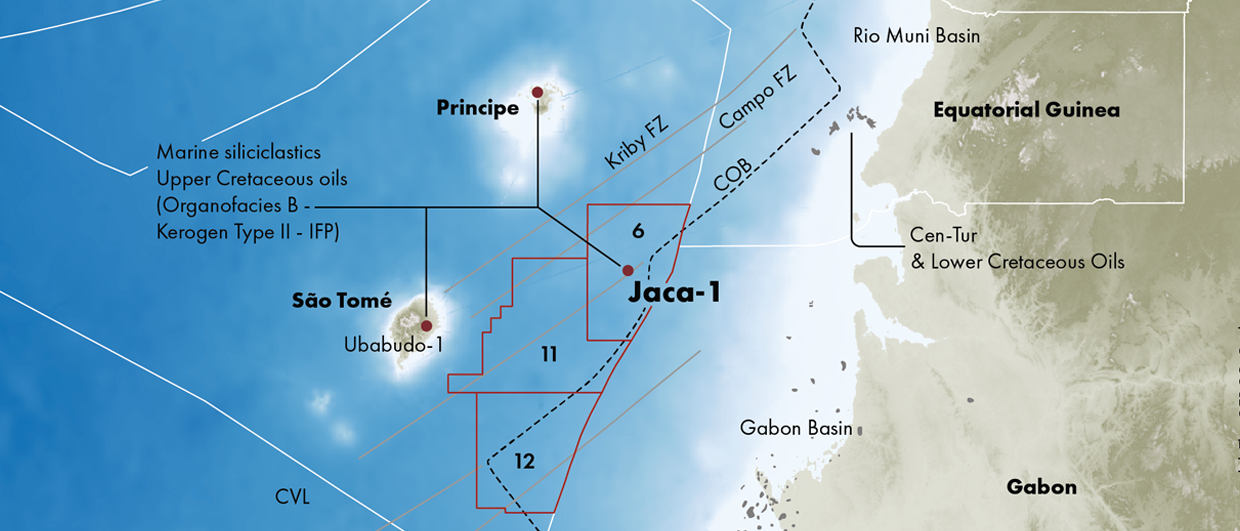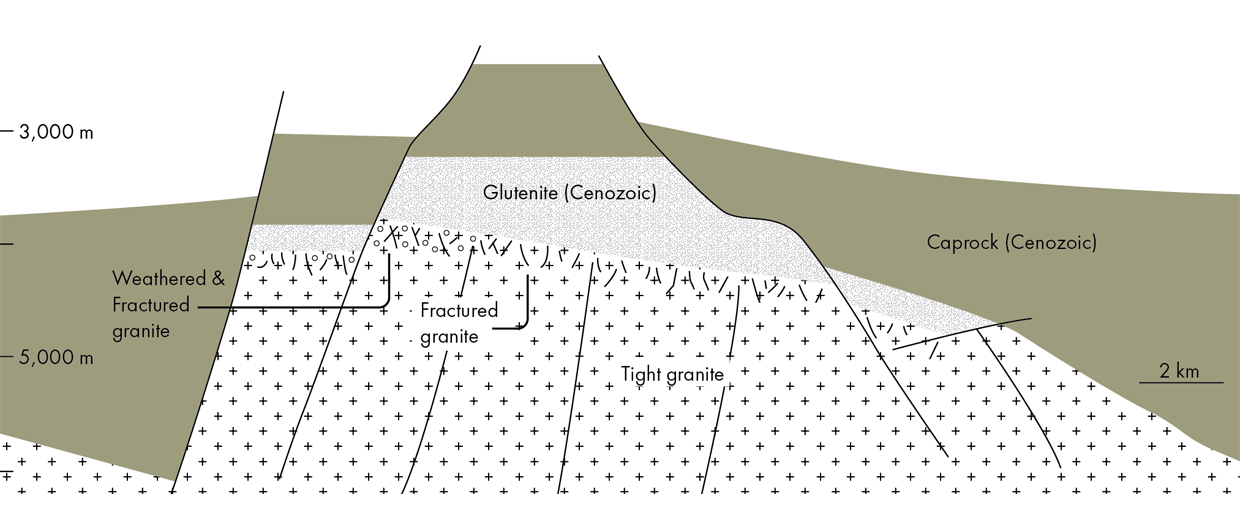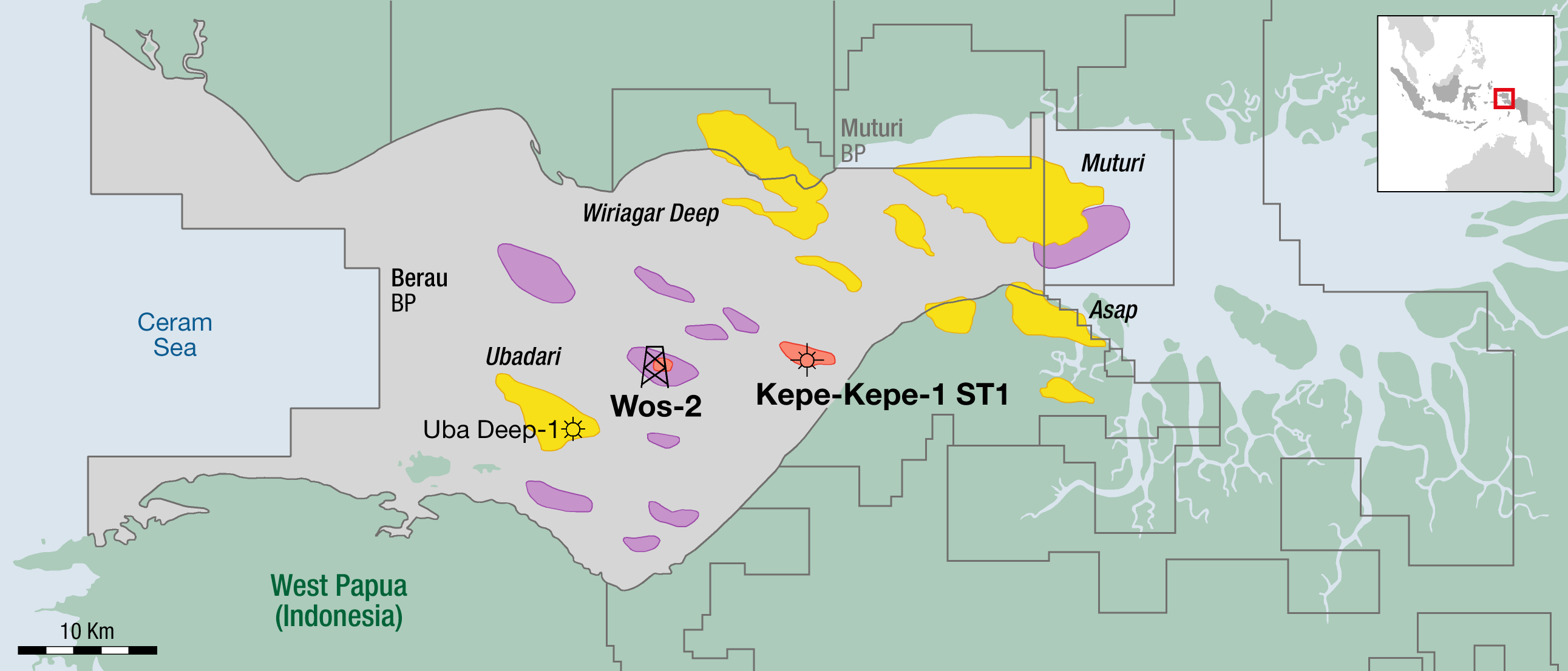Covering an area roughly the size of California and Texas combined, the US Atlantic margin is underexplored, but prospective basins along the margin may once again be open to exploration.
North Atlantic gravity map including key discoveries off Canada and north-west Africa. The prominent gravity high that trends south out of Nova Scotia and into the US portion of the Atlantic margin marks the extent of the shelf and closely follows the Mesozoic carbonate platform edge. Modified from Egorov, 2017.
The US Atlantic margin is virtually unexplored. Ten lease sales were held in the Atlantic Outer Continental Shelf (OCS) between 1976 and 1983. The entire region has been penetrated by a total of only 51 wells, all drilled between 1975 and 1984. Of those, five were COST (Continental Offshore Stratigraphic Tests) wells and 46 industry exploration wells.
Along the adjacent and conjugate Atlantic margins of Canada, Ireland, and the central and northern African coast, extensive exploration activity has yielded numerous large oil and gas discoveries in strata similar to those found along the US Atlantic margin. Yet the US Atlantic OCS remains a true frontier for exploration companies and an area that could keep the country a top energy producer. In the latest assessment, the Bureau of Ocean Energy Management (BOEM, 2014/2016) estimated undiscovered technically recoverable resources and respective probabilities for the Atlantic OCS for oil to be between 1.150 (95%) and 9.185 (5%) Bb and gas to be 12.80 (95%) to 68.71 (5%) Tcf.
Licencing Laws of The US Outer Continental Shelf
US Atlantic margin bathymetry map showing three areas drilled (Georges Bank Basin, Baltimore Canyon Trough, and SE Georgia Embayment) during a ten-year exploration period that ended in 1984. Only a few wells in the Baltimore Canyon tested non-commercial gas flows. The red line outlines the US OCS protraction area’s boundary. Image: Egorov et al., 2014
The current National Outer Continental Shelf Oil and Gas Leasing Program, adopted in 2016, includes ten lease sales for the Gulf of Mexico and one for Alaska, but nothing off either the west or east coasts of the US. This current leasing program, which covers 2017–2022, puts 94% of the US OCS off limits to exploration. Encouraged by letters from members of both the US House of Representatives and the US Senate, Secretary of the Interior Ryan Zinke proposed a new National OCS Leasing Program for 2019–2024 that includes 47 potential lease sales in 25 of the 26 planning areas. If adopted as proposed, this Draft Proposed Program could result in over 90% of the total OCS acreage and 98% of the undiscovered, technically recoverable oil and gas resources in the federal OCS being made available for future exploration and development. Nine lease sales would occur in the Atlantic Region, with the first two, which would cover much of the US Atlantic margin, scheduled for 2020.
The new leasing program is currently in the development process, which includes stakeholder and public feedback, along with new scientific information to further refine the geographic scope of leasing areas. The 2017–2022 National OCS Program took about a year and a half to complete and will be in force until the new program is approved.
Available Geological & Geophysical Data
Although no wells have been drilled since 1984 and no major geophysical surveys were conducted offshore US East Coast, there have definitely been some advances in both available data and research. Additional information can also be gleaned from exploration work and discoveries in other areas along the Atlantic margins.
(a) Crustal types and some of the potential plays found along the Atlantic margins. Many of these plays depicted here have not been tested in the US Atlantic margin (Egorov, 2017).
Legacy seismic data have limitations in resolution and high-frequency content, but although overall not of up-to-date quality, they contain lots of useful information. According to BOEM (2014/2016), 239,000 line-miles (385,000 line-km) of 2D seismic were collected during the exploration activities from 1966 into the 1980s. Most of these data are publicly available. Additionally, a number of seismic companies undertook reprocessing, migration and depth-conversion of these legacy data, including Spectrum Geo, whose seismic depth-converted cross-sections are shown in this article.
Developments in space technologies have led to the emergence of satellite altimetry-derived gravity and continuous improvement of this worldwide offshore dataset. Various magnetic data were also compiled over the years. Both gravity and magnetics have proved valuable in the understanding of continental margins and petroleum exploration along these margins.
Geological Assessment of the US Atlantic Margin
(b) Intra-graben structures, stratigraphic pinch-outs towards structural highs, and hydrothermal dolomites (Egorov, 2017. Seismic data courtesy Spectrum Geo.)
The closing of the Iapetus Ocean and the Laurentia-Gondwana collision in Carboniferous-Permian time led to the formation of the Appalachian fold and thrust belt. Following these events, the Late Triassic – Early Jurassic extension initiated the opening of the Atlantic between North America and Africa. The Appalachian orogen acted both as a source of sediments and a major zone of weakness. It partially accommodated Mesozoic extension by ‘unbuckling’ along pre-existing thrust faults and sutures. Triassic-Jurassic grabens and half-grabens are well documented onshore along the margin and propagate offshore in the northern part of the US margin. Detailed offshore distribution of these extensional structures requires additional studies. However, they are not as obvious and widespread as in many other parts of the Atlantic, indicating that a large portion of the offshore sediments was probably deposited during a passive (post-rift) margin regime.
The BOEM defined five major Jurassic-Cenozoic depocenters along the margin: the Georges Bank Basin, Baltimore Canyon Trough, Carolina Trough, South-East Georgia Embayment, and Blake Plateau Basin. Three of these areas were drilled, penetrating Cenozoic, Cretaceous, and in most cases Jurassic sediments. Few wells within the Georges Bank Basin and the South-East Georgia Embayment reached underlying Paleozoic metasediments. The deepest well was drilled in the Baltimore Canyon Trough and reached a depth of 6,584m.
(c) Shelf shallow marine/deltaic sand reservoirs in the roll-over fault-controlled structural traps (Egorov, 2017. Seismic data courtesy Spectrum Geo.)
Expanding on the mid-continent onshore success of discoveries associated with Paleozoic reefs, the majority of the offshore drilling efforts were focused on similar structures. Many interpreted pinnacle reefs within the Mesozoic carbonate platform were drilled but resulted in dry holes. These results were attributed to an absence of a hydrocarbon charging system, while some of the ‘reefs’ turned out to be volcanics. Yet another concept was brought into exploration from Gulf Coast and Gulf of Mexico salt basins. The early interpretation of seismic data from the Baltimore Canyon Trough indicated very prominent salt diapirs. However, drilling results, additional seismic data and later reprocessing all demonstrated that salt diapirs do not exist in the Baltimore Canyon Trough and are absent along most parts of the margin, with the possible exception of the Carolina Trough area. A few wells tested deltaic deposits but found a disappointing dominance of shales and siltstones and an absence of good quality reservoir rocks. The only proven play with non-commercial gas discoveries was related to listric fault-controlled deltaic reservoirs within the inner shelf (Hudson Canyon 598 area).
Conjugate Margin Analogues
(d) Deepwater channels and fans. (Egorov, 2017. Seismic data courtesy Spectrum Geo.)
While petroleum exploration off the US east coast practically stopped after the 1980s, it continued to the north in Canada and along the north-west African coast, the conjugate margin to the US Atlantic OCS. Studying analogs from conjugate margins has proved to be a great exploration approach, resulting in many major discoveries on both sides of the Atlantic. The subsalt discoveries offshore Brazil (Tupi and others) were followed by similar discoveries off Angola; the Jubilee turbidite play discovery offshore Ghana led to the discovery of analogous plays off Sierra-Leone and French Guiana. Studying these analogs is key to predicting US offshore plays and estimating hydrocarbon resources.
Recent exploration along the northwest African coast has led to several significant discoveries pertinent to exploration off the US east coast. The largest offshore discovery of 2014 was the SNE-1 field offshore Senegal. The hydrocarbon-bearing reservoir was defined by Cairn Energy as an Early Albian sandy pro-delta turbidite apron and delta-fed ramp. These deposits are within the extent of a Jurassic-Cretaceous carbonate platform. Following SNE-1, the FAN-1 discovery was made outboard of the platform within deepwater sediments comprising Albian contourites, gravity deposits and base of slope turbidite fans. In 2014 Kosmos announced the discovery of the Great Tortue gas field offshore Mauritania and Senegal with Cenomanian and Albian turbidite reservoirs. These deepwater plays also exist offshore US but are yet to be tested.
Hydrocarbon Activity in the Jeanne d’Arch Basin, Canada
Exploration offshore Canada’s east coast remains active. The Jeanne d’Arc basin off Newfoundland remains the only oil-producing province along the North American Atlantic margin. The Late Jurassic and Early Cretaceous sandstones produce nearly 35% of Canada’s light crude, making Newfoundland and Labrador the second largest oil-producing province in Canada. Recent light oil discoveries in the deepwater Flemish Pass Basin are opening up a new oil and gas frontier offshore the province.
West to east regional seismic section across the Georges Bank Basin showing major geologic features that include rift structures, the Mesozoic carbonate platform edge, and seaward dipping reflectors that indicate transitional crust. Corresponding gravity and magnetic profiles are presented across the top. Red boxes show approximate settings of the three plays shown in the figure on page 21. (Modified from Egorov, 2017. Seismic data courtesy Spectrum Geo.)
Natural gas fields discovered in the 1970s to 90s offshore Nova Scotia lie just north of the US east coast OCS. Reservoirs include Late Jurassic dolomitized carbonates and Late Jurassic to Early Cretaceous fluvial, deltaic, and shallow marine sandstones. More recently, oil companies have leased deepwater blocks, some in an area next to the Georges Bank just north of the border, and 3D wide azimuth seismic has been shot prior to drilling. Shell has drilled two wells in the deepwater Shelburne Basin and BP plans to drill a deepwater prospect approximately 300 km offshore Nova Scotia sometime this year. This is the only well expected in the area in 2018 and its results are highly anticipated.
Similar plays trend south and can be expected along the US Atlantic margin where they have either not been tested or tested only within three small areas. Meanwhile, an enormous portion of the OCS remains unexplored. Based on available data and analogs from continental margins, BOEM has identified ten potential offshore plays, including shallow and deepwater reservoirs both structurally and stratigraphically controlled.
Mature source rocks have yet to be identified along the US Atlantic margin. Non-commercial gas discoveries in the Baltimore Canyon Trough provide proof of a working petroleum system and suggest that mature source rocks are present off the eastern US coast. Wells have penetrated potential Cretaceous source rocks that were immature where drilled but could be mature seaward. Jurassic source rocks present in the productive basins off eastern Canada are expected to trend south along the US Atlantic margin.
First Steps for Exploration Along US Atlantic Margin
It took years of intensive acquisition and analysis of geophysical and geological data and, eventually, exploratory drilling before success came to the basins adjacent and conjugate to the US Atlantic margin. Time will tell if any of the prospects and plays lining the US East Coast will be tested. First steps are starting to take shape in the form of proposed lease sales and new regulations governing oil and gas activity. Then it will be up to the oil and gas companies to obtain leases and explore the frontier basins lying just off the east coast of United States.
Acknowledgements
Author greatly appreciates knowledge shared with him over the years by many people working on the North American Atlantic margin and, especially, Paul Post (BOEM), David Brown (CNSOBP), and Bill Dickson (DIG’s International), and is thankful to Thomas Smith (Geo ExPro) for inviting and editing this publication.
Special acknowledgement goes to Spectrum Geo USA for permission to show seismic data and especially to Richie Miller, Mike Saunders, Laurie Geiger, and Denny Leung.
References
Egorov,V., F. Murphy, P. Versnel, R. Poujardieu, and C. Anderson, 2014, US East Coast: From regional framework to FTG applicability evaluation, 4th Atlantic Conjugate Margins Conference, St. John’s, NL, Canada, Abstract Vol., 91-94.
Egorov, V., 2017, The largest frontier of the Atlantic: Offshore US, AAPG Annual Meeting, Houston, TX.
Post, P.J., E.T. Elliot, R.J. Klazynski, E.S. Klocek, T.M. Decort, T.J. Riches Jr. and Kun Li, 2014, US Central Atlantic: new plays and petroleum prospectivity, Geological Society, London, Special Publications 2013, v.369, 323-336.
Post, P.J., E.T. Elliot, R.J. Klazynski, E.S. Klocek, T.J. Riches Jr. and Kun Li, 2016, Inventory of technically and economically recoverable hydrocarbon resources of the Atlantic Outer Continental Shelf as of January 1, 2014, OCS Report, BOEM 2016-071, U.S. Department of the Interior, Bureau of Ocean Energy Management, Gulf of Mexico OCS Regional Office, Office of Resource Evaluation, New Orleans.
Withjack, M.O., R.W. Schlische and P.E. Olsen, 2012, Development of the passive margin of Eastern North America: Mesozoic rifting, igneous activity, and breakup, in Regional Geology and Tectonics: Phanerozoic Rift Systems and Sedimentary Basins, editors D.G. Roberts and A.W. Bally, 301-335.




